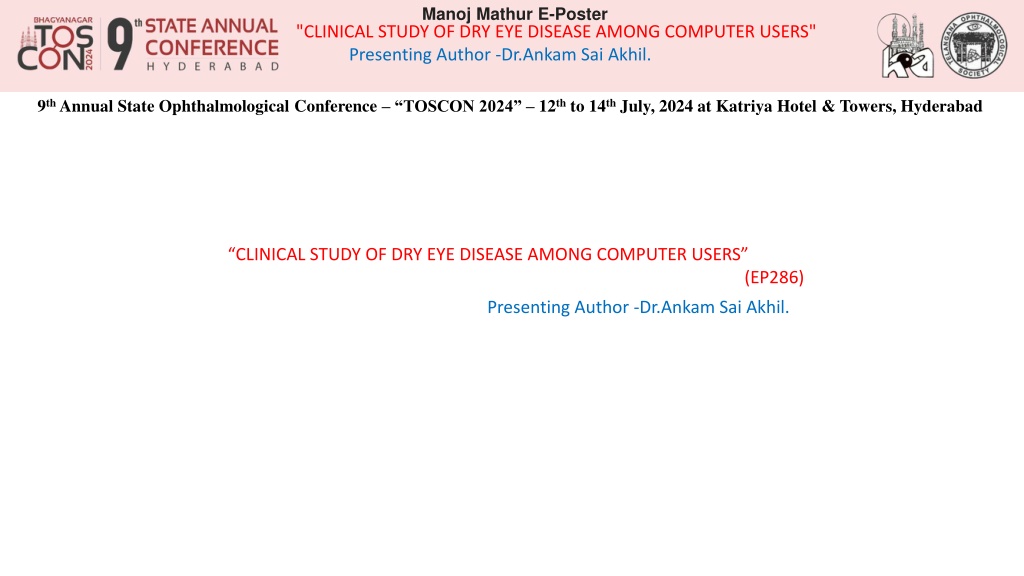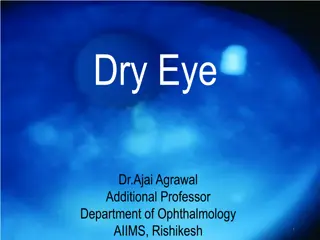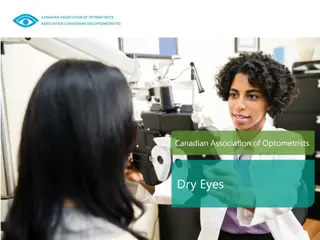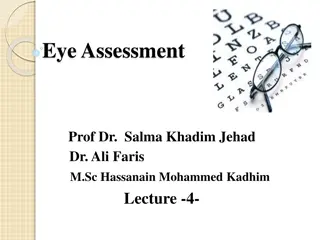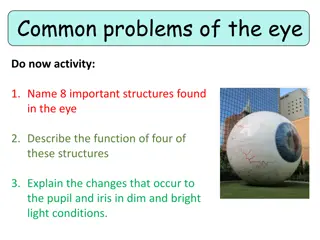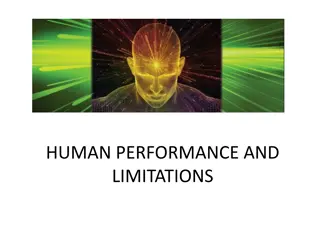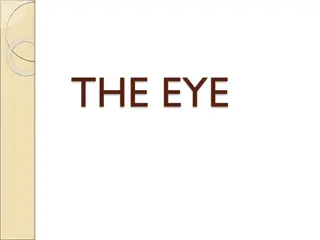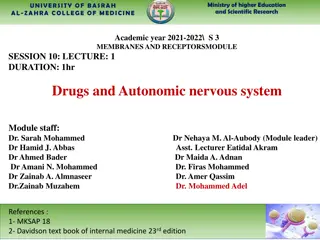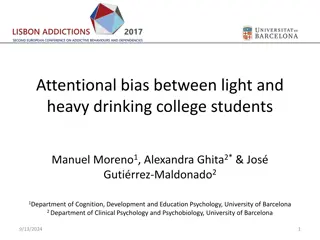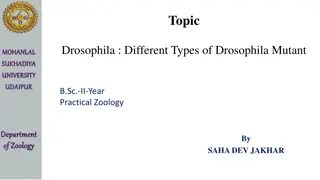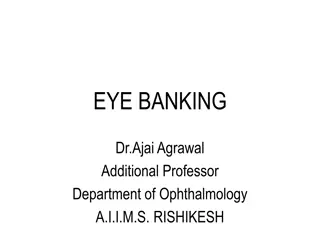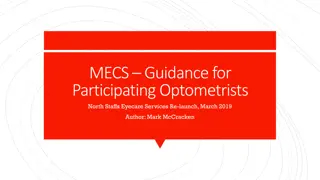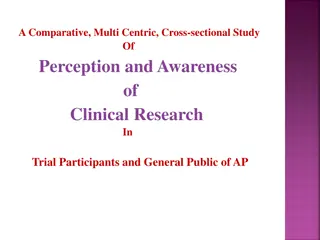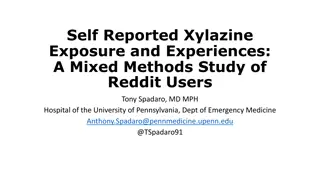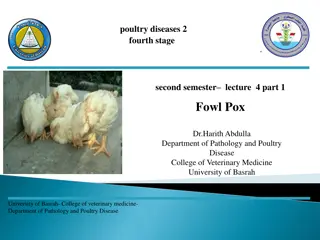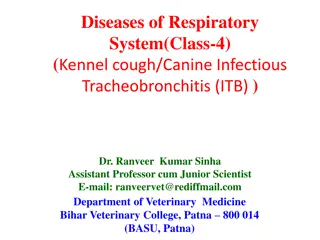Clinical Study of Dry Eye Disease Among Computer Users
Dry eye disease (DED) is a common ocular condition, particularly among computer users due to factors like decreased blink rate, environmental conditions, and visual display terminal use. This clinical study by Dr. Ankam Sai Akhil aims to assess the prevalence, causative factors, awareness, and risk factors of DED among computer users attending Santhiram General Hospital, Nandyal. The study involves evaluating tear film tests, comparing stains for assessing the ocular surface, and conducting thorough examinations on a sample of 100 computer users. Findings from this study can provide insights into managing and preventing dry eye symptoms among individuals who frequently use computers.
Download Presentation

Please find below an Image/Link to download the presentation.
The content on the website is provided AS IS for your information and personal use only. It may not be sold, licensed, or shared on other websites without obtaining consent from the author. Download presentation by click this link. If you encounter any issues during the download, it is possible that the publisher has removed the file from their server.
E N D
Presentation Transcript
Manoj Mathur E-Poster "CLINICAL STUDY OF DRY EYE DISEASE AMONG COMPUTER USERS" Presenting Author -Dr.Ankam Sai Akhil. 9thAnnual State Ophthalmological Conference TOSCON 2024 12thto 14thJuly, 2024 at Katriya Hotel & Towers, Hyderabad CLINICAL STUDY OF DRY EYE DISEASE AMONG COMPUTER USERS (EP286) Presenting Author -Dr.Ankam Sai Akhil.
Manoj Mathur E-Poster CLINICAL STUDY OF DRY EYE DISEASE AMONG COMPUTER USERS Presenting Author -Dr.Ankam Sai Akhil. 9th Annual State Ophthalmological Conference TOSCON 2024 12th to 14th July, 2024 at Katriya Hotel & Towers, Hyderabad INTRODUCTION Dry eye disease (DED) is one of the most frequently encountered ocular morbidities. In many countries, approximately 1 in 4 patients consulting an ophthalmologist complains of the symptoms of dry eye . Dry eye symptoms can be intensified in most cases by environmental factors such as. air conditioning and work at a Visual Display Terminal (VDT). Possible explanation for dry eye disease among computer users is decreased blink rate due to concentration on the task or a relatively limited. range of movements. Staring and decreased blinking dry the eyes out. Although Book reading and computer work result in significantly decreased. blink rates, difference between them is that computer work usually requires a higher gaze angle, resulting in increased rate of tear evaporation . Also higher gaze angle results in a greater percentage of incomplete blinks. Office air environment is low in humidity and can contain contaminants. The static electricity generated by the display screen itself attracts dust particles into the immediate area. These contribute to particulate matter entering the eye leading to dry eye symptoms
Manoj Mathur E-Poster CLINICAL STUDY OF DRY EYE DISEASE AMONG COMPUTER USERS Presenting Author -Dr.Ankam Sai Akhil. 9th Annual State Ophthalmological Conference TOSCON 2024 12th to 14th July, 2024 at Katriya Hotel & Towers, Hyderabad AIMS AND OBJECTIVES To study the prevalence of dry eye disease in the patients who are computer users attending Santhiram General Hospital, Nandyal To study the effects of working environment in the causation of Dry eye disease To study the awareness among computer users regarding symptoms of Dry eye To evaluate the ocular risk factors involved in the causation of Dry eye disease. Case control study to evaluate the efficacy of tear film tests in Evaporative dry eye disease To compare the efficacy of Fluorescein and Lissamine green stains in assessing the status of anterior ocular surface MATERIALS AND METHODS A clinical study of dry eye disease has been undertaken on different patients who are using computers, for at least 2 hours every day. The study was carried out at the Department of Ophthalmology, Santhiram General Hospital, Nandyal. In this study, 100 patients, who were known computer users presenting with various ophthalmic problems to Santhiram general Hospital, Nandyal were screened for dry eye. The patients were selected and informed about the nature of the study. Patients suffering from acute eye infections and those who had undergone extra ocular or intra-ocular surgery within 6 months were excluded. Informed consent was obtained from subjects recruited for the study. A detailed general (including history of systemic disease, pertaining to dry eye) and ophthalmic history was elicited, followed by systemic and ocular examination. Subsequently, the dry eye questionnaire was administered.
Manoj Mathur E-Poster CLINICAL STUDY OF DRY EYE DISEASE AMONG COMPUTER USERS Presenting Author -Dr.Ankam Sai Akhil. 9th Annual State Ophthalmological Conference TOSCON 2024 12th to 14th July, 2024 at Katriya Hotel & Towers, Hyderabad DISCUSSION The incidence of dry eye syndrome is very common among computer users. (thirty eight percent, 38/100) of the computer users showed evidence of dry eye disease. Most of the patients are aged between 20 and 40 years. The disease is more common in this age group because they are occupationally more active. Most of the patients are males who outnumbered females in the ratio of 1.11:1 The most common presenting complaint was burning sensation in eyes, followed by reduction in vision, foreign body sensation and watering of eyes. 74% of the patients were aware about the dry syndrome occurring among computer users. Air pollution, smoking, air conditioning were significantly influential in the causation of dry eye disease. Contact lens users were more prone (3/6=50%) to the development of dryeye disease. Refractive errors, especially if left uncorrected will lead to the development of dry eye. People who are using computers for over 2 years and working on them for more than 4 hours each day developed dry eye disease. Lissamine Green stain is as efficacious as fluorescein sodium stain in assessing the health of anterior ocular surface, but the former is less irritative to the patient.
Manoj Mathur E-Poster CLINICAL STUDY OF DRY EYE DISEASE AMONG COMPUTER USERS Presenting Author -Dr.Ankam Sai Akhil. 9th Annual State Ophthalmological Conference TOSCON 2024 12th to 14th July, 2024 at Katriya Hotel & Towers, Hyderabad DISCUSSION Computer centre operators are more prone to the development of dry eye disease (6/10=60%) and so are engineers who work on computers for prolonged periods. The two tear film tests, Schirmer's and tear film break up time were efficacious in detecting dry eye disease. CONCLUSION Dry eye induced by environmental exposure, to which this 21-40 age group, being the most active occupationally, is exceptionally prone. Subjects with refractive errors, those working in air conditioned facilities, those exposed to air pollution and smoking had a higher incidence of dry eye Hence it is very important to educate all patients including computer users about the symptoms of dry eye and the associated risk factors like contact lenses, smoking, unfavourable working environment and ocular conditions like chronic blepharitis and refractive errors that lead to dry eye.
Manoj Mathur E-Poster CLINICAL STUDY OF DRY EYE DISEASE AMONG COMPUTER USERS Presenting Author -Dr.Ankam Sai Akhil. 9th Annual State Ophthalmological Conference TOSCON 2024 12th to 14th July, 2024 at Katriya Hotel & Towers, Hyderabad REFERENCES prevalence of dry eye disease among Japanese visual display terminal users M Uchino, DA Schaumberg, M Dogru, Y Uchino... Ophthalmology, 2008 - Elsevier Wolfs Anatomy of eye and orbit, 5th edition. Page 72-85 A.K.Khurana, Indu Khurana; Modern system of Ophthalmology. "Anatomy and Physiology of Eye" 2nd Edition, Page 378 J. Lakshmi Prabha, "Tear secretion--a short review." Journal of Pharmaceutical Sciences and Research, vol. 6, no. 3, pp. 155-157,2014. E. Peters and K. Colby, "The tear film," in Foundation Volume 2:Physiology of the Eye and Visual System, W. Tasman and E. A.Jaeger, Eds., Duane's Foundations of Clinical Ophthalmology. Lippincott Williams & Wilkins, Philadelphia, Pa, USA, 2006 J. P. Craig and A. Tomlinson, "Importance of the lipid layer in human tear film stability and evaporation," Optometry and Vision Science,vol. 74, no. 1, pp. 8-13, 1997. J. P. McCulley and W. E. Shine, "The lipid layer of tears: dependent on meibomian gland function," Experimental Eye Research, vol. 78, . 3, . 361-365, 2004. H. M. Tabery,"The mucus in the preocular tear film," in Keratoconjunctivitis Sicca and Filamentary Keratopathy: In VivoMorphology in the Human Cornea and Conjunctiva, H. M. Tabery, Ed.,pp. 1-14, Springer. Berlin, Germany,2012. J. M. Tiffany,"Tears in health and disease," Eye, vol. 17, no. 8, pp.923-926, 2003
